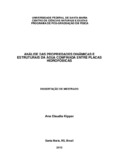| dc.creator | Kipper, Ana Claudia | |
| dc.date.accessioned | 2017-05-02 | |
| dc.date.available | 2017-05-02 | |
| dc.date.issued | 2013-04-26 | |
| dc.identifier.citation | KIPPER, Ana Claudia. Analysis of structural and dynamic properties of water confined between hydrophobic plates. 2013. 75 f. Dissertação (Mestrado em Física) - Universidade Federal de Santa Maria, Santa Maria, 2013. | por |
| dc.identifier.uri | http://repositorio.ufsm.br/handle/1/9250 | |
| dc.description.abstract | In this work we studied the properties of confined water by graphene sheets via Classical
Molecular Dynamics. The main objective of this dissertation is to understand how the
structural and dynamic properties of confined water can be changed due to the geometric
confinement, including the density profile, formation of layering, the average number
of hydrogen bonds and the diffusion process of water molecules. The confinement geometry
is formed by two graphene sheets aligned parallel with respect to one another
separated by a distance "d". Both the distance "d" as the system temperature were varied
to obtain different degrees of confinement and thermodynamic conditions. Values used
were d=7, 9, 11, 15, 20, 25 and 30Å and T=280, 300 and 320K. Furthermore, all simulations
were carried out with GROMACS (GROningen Machine for Chemical Simulations)
code in a NVT ensemble (particle number, volume and pressure are kept constant) and
using SPC/E (Simple Point Charge/Extend) water model. For these systems have been
found that confinement induces the formation of layers of water molecules and the number
of layers depend on the degree of confinement. Due to this structure, we analyzed
the average number of hydrogen bonds with water molecules and these molecules in the
respective diffusion layers (central and near the confining walls). It was concluded that the
formation of layers is directly related to the breaking of hydrogen bonds. | eng |
| dc.description.sponsorship | Coordenação de Aperfeiçoamento de Pessoal de Nível Superior | |
| dc.format | application/pdf | por |
| dc.language | por | por |
| dc.publisher | Universidade Federal de Santa Maria | por |
| dc.rights | Acesso Aberto | por |
| dc.subject | Água | por |
| dc.subject | Grafeno | por |
| dc.subject | Confinamento | por |
| dc.subject | Water | eng |
| dc.subject | Graphene | eng |
| dc.subject | Confinement | eng |
| dc.title | Análise das propriedades dinâmicas e estruturais da água confinada entre placas hidrofóbicas | por |
| dc.title.alternative | Analysis of structural and dynamic properties of water confined between hydrophobic plates | eng |
| dc.type | Dissertação | por |
| dc.description.resumo | Neste trabalho estudamos as propriedades da água confinada por folhas de grafeno via
Dinâmica Molecular Clássica. O principal objetivo dessa dissertação é compreender
como as propriedades dinâmicas e estruturais da água confinada podem ser alteradas
devido ao confinamento geométrico, entre elas o perfil da densidade, a formação de camadas,
o número médio de ligações de hidrogênio e o processo difusivo das moléculas
de água. A geometria confinante foi construída através de duas folhas de grafeno alinhadas
paralelamente uma em relação a outra separadas por uma distância "d". Tanto
a distância "d" como a temperatura do sistema foram variadas de modo a obtermos diferentes
graus de confinamento e condições termodinâmicas. Os valores utilizados foram
d=7, 9, 11, 15, 20, 25 e 30Å e T=280, 300 e 320K. Além disso, todas as simulações foram
realizadas com o código computacional GROMACS (do inglês GROningen Machine for
Chemical Simulations) em um ensemble NVT (ensemble onde o número de partículas,
volume e pressão são mantidos constantes) usando o modelo de água SPC/E (do inglês
Simple Point Charge/Extend). Para esses sistemas foi encontrado que o confinamento
induz a formação de camadas de moléculas de água e o número de camadas dependem
do grau de confinamento. Devido a esta estruturação, foi analisado o número médio de
ligações de hidrogênio por moléculas de água e a difusão dessas moléculas nas respectivas
camadas (central e próximas as paredes confinantes). Concluiu-se que a formação
de camadas está diretamente relacionado com a quebra das ligações de hidrogênio. | por |
| dc.contributor.advisor1 | Silva, Leandro Barros da | |
| dc.contributor.advisor1Lattes | http://buscatextual.cnpq.br/buscatextual/visualizacv.do?id=K4775871P0 | por |
| dc.contributor.referee1 | Santos, Cláudia Lange dos | |
| dc.contributor.referee1Lattes | http://buscatextual.cnpq.br/buscatextual/visualizacv.do?id=K4138066Z2 | por |
| dc.contributor.referee2 | Zimmer, Fábio Mallmann | |
| dc.contributor.referee2Lattes | http://buscatextual.cnpq.br/buscatextual/visualizacv.do?id=K4775428P9 | por |
| dc.creator.Lattes | http://lattes.cnpq.br/2727127291079776 | por |
| dc.publisher.country | BR | por |
| dc.publisher.department | Física | por |
| dc.publisher.initials | UFSM | por |
| dc.publisher.program | Programa de Pós-Graduação em Física | por |
| dc.subject.cnpq | CNPQ::CIENCIAS EXATAS E DA TERRA::FISICA | por |


